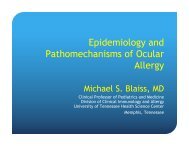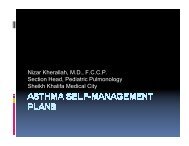scientific program - World Allergy Organization
scientific program - World Allergy Organization
scientific program - World Allergy Organization
Create successful ePaper yourself
Turn your PDF publications into a flip-book with our unique Google optimized e-Paper software.
124<br />
Seaplane landing at sunset<br />
Granville Island<br />
WAO Congress–XVIII ICACI Final Program<br />
VANCOUVER CANADA<br />
Everything allergic eyes need<br />
■ The only mast-cell stabilizer/antihistamine approved to treat all the<br />
signs and symptoms of allergic conjunctivitis<br />
Itching Lid swelling Redness Tearing Conjunctival chemosis<br />
■ Convenient b.i.d. dosing with safety and excellent comfort for patients<br />
as young as 3 years of age<br />
ALLERGIC EYES STOP HERE<br />
DESCRIPTION<br />
PATANOL ® (olopatadine hydrochloride ophthalmic solution) 0.1% is a sterile ophthalmic<br />
solution containing olopatadine,a relatively selective H 1-receptor antagonist and<br />
inhibitor of histamine release from the mast cell for topical administration to the eyes.<br />
INDICATIONS AND USAGE<br />
PATANOL (olopatadine hydrochloride ophthalmic solution) 0.1% is indicated for the<br />
treatment of the signs and symptoms of allergic conjunctivitis.<br />
CONTRAINDICATIONS<br />
PATANOL is contraindicated in persons with a known hypersensitivity to olopatadine<br />
hydrochloride or any components of PATANOL.<br />
WARNINGS<br />
PATANOL is for topical use only and not for injection or oral use.<br />
PRECAUTIONS<br />
Information for Patients: To prevent contaminating the dropper tip and solution,<br />
care should be taken not to touch the eyelids or surrounding areas with the dropper<br />
tip of the bottle. Keep bottle tightly closed when not in use.<br />
Patients should be advised not to wear a contact lens if their eye is red. PATANOL ®<br />
should not be used to treat contact lens related irritation. The preservative in PATANOL,<br />
benzalkonium chloride,may be absorbed by soft contact lenses. Patients who wear<br />
soft contact lenses and whose eyes are not red should be instructed to wait at<br />
least ten minutes after instilling PATANOL before they insert their contact lenses.<br />
Carcinogenesis, Mutagenesis, Impairment of Fertility: Olopatadine administered<br />
orally was not carcinogenic in mice and rats in doses up to 500 mg/kg/day and 200<br />
mg/kg/day,respectively. Based on a 40 µL drop size,these doses were 78,125 and<br />
31,250 times higher than the maximum recommended ocular human dose (MROHD).<br />
No mutagenic potential was observed when olopatadine was tested in an in vitro<br />
bacterial reverse mutation (Ames) test,an in vitro mammalian chromosome aberration<br />
assay or an in vivo mouse micronucleus test. Olopatadine administered to male and<br />
female rats at oral doses of 62,500 times MROHD level resulted in a slight decrease<br />
in the fertility index and reduced implantation rate; no effects on reproductive function<br />
were observed at doses of 7,800 times the maximum recommended ocular human<br />
use level.<br />
Pregnancy: Pregnancy Category C. Olopatadine was found not to be teratogenic in<br />
rats and rabbits. However,rats treated at 600 mg/kg/day,or 93,750 times the MROHD and<br />
rabbits treated at 400 mg/kg/day,or 62,500 times the MROHD,during organogenesis<br />
showed a decrease in live fetuses. There are,however,no adequate and well controlled<br />
studies in pregnant women. Because animal studies are not always predictive of<br />
human responses,this drug should be used in pregnant women only if the potential<br />
benefit to the mother justifies the potential risk to the embryo or fetus.<br />
Nursing Mothers: Olopatadine has been identified in the milk of nursing rats<br />
following oral administration. It is not known whether topical ocular administration<br />
could result in sufficient systemic absorption to produce detectable quantities in<br />
the human breast milk. Nevertheless,caution should be exercised when PATANOL<br />
is administered to a nursing mother.<br />
Pediatric Use: Safety and effectiveness in pediatric patients below the age of<br />
3 years have not been established.<br />
ADVERSE REACTIONS<br />
Headaches have been reported at an incidence of 7%. The following adverse experiences<br />
have been reported in less than 5% of patients: Asthenia,blurred vision,burning or<br />
stinging,cold syndrome,dry eye,foreign body sensation,hyperemia,hypersensitivity,<br />
keratitis,lid edema,nausea,pharyngitis,pruritus,rhinitis,sinusitis,and taste perversion.<br />
Some of these events were similar to the underlying disease being studied.<br />
DOSAGE AND ADMINISTRATION<br />
The recommended dose is one drop in each affected eye two times per day at an<br />
interval of 6 to 8 hours.<br />
HOW SUPPLIED<br />
PATANOL (olopatadine hydrochloride ophthalmic solution) 0.1% is supplied as follows:<br />
5 mL in plastic DROP-TAINER ® dispenser.<br />
5 mL NDC 0065-0271-05.<br />
Rx Only<br />
U.S. Patents Nos. 4,871,865; 4,923,892; 5,116,863; 5,641,805.<br />
Revised: April 2000<br />
References:<br />
1. SourceTM Prescription Audit (SPA),<br />
Scott-Levin,Inc.,November 2000-October 2001.<br />
2. SourceTM Prescription Audit (SPA),<br />
Scott-Levin,Inc.,March 1997-November 2001.<br />
ALCON LABORATORIES, INC.<br />
Fort Worth, Texas 76134<br />
www.alconlabs.com<br />
©2002 Alcon Laboratories,Inc. 4/02 PT02502JA Printed in U.S.A.<br />
®

















